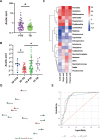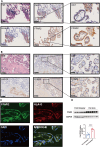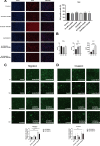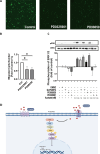Microbiome-producing SCFAs are associated with preterm birth via trophoblast function modulation
- PMID: 39526775
- PMCID: PMC11633107
- DOI: 10.1128/mbio.02702-24
Microbiome-producing SCFAs are associated with preterm birth via trophoblast function modulation
Abstract
Although preterm birth (PTB) is one of the major causes of perinatal mortality and neonatal morbidity, little is known about its complex etiology. An abnormal cervicovaginal microbiome during pregnancy is associated with an increased risk of PTB. The cervicovaginal microbiota and its active metabolites, such as short-chain fatty acids (SCFAs), might be effectively used to predict and diagnose PTB. However, the roles of these proteins and the underlying mechanisms involved remain elusive. We conducted 16S rRNA gene sequencing and used a targeted metabolomics approach to study cervicovaginal swabs obtained from 51 singleton pregnancies and 52 twin pregnancies in the second trimester. Next, functional in vitro experiments were performed to investigate the roles and mechanisms of SCFAs in placental trophoblast cells (HTR8/SVneo cells). Significant cervicovaginal microbiome dysbiosis, characterized by a substantial reduction in the abundance of lactobacilli and overgrowth of anaerobes, was revealed in the second trimester and was strongly associated with subsequent PTB (P = 0.036). Among the paired samples (n = 103), acetic acid was significantly greater in the preterm group than in the term group (P = 0.047). Data obtained from integrated gas chromatography‒mass spectrometry and 16S RNA studies revealed metabolites that were distinctly associated with particular microbial communities. Gardnerella vaginalis was the species most positively associated with acetic acid content. In addition, we identified a marker set consisting of the pregnancy type, acetic acid concentration, and community state type to accurately diagnose PTB. Acetate was associated with increased interleukin (IL)-8 and IL-6 levels and extravillous trophoblast cell migration and invasion through the activation of the extracellular signal-regulated kinase 1/2 signaling pathway in HTR8/SVneo cells. Cervicovaginal microbiota dysbiosis is an important etiological factor of PTB. The cervicovaginal microbiota and its active metabolites can be efficiently used to predict and diagnose PTB. Our findings enrich the microbiota-placenta axis theory and contribute to the development of microecological products for pregnancy.
Importance: Preterm birth (PTB) is a leading cause of infant mortality and long-term health issues, affecting millions of families worldwide. Despite its prevalence, the exact causes of PTB remain unclear. Our study reveals that certain bacteria and their metabolic byproducts in the cervicovaginal environment, specifically short-chain fatty acids (SCFAs), are linked to the risk of preterm birth. By analyzing samples from pregnant women, we found that an imbalance in the vaginal microbiota and increased levels of SCFAs are associated with changes in cells that can lead to early labor. This research provides new insights into how the microbiome influences pregnancy outcomes and highlights potential biomarkers for predicting preterm birth. Understanding these microbial influences could lead to innovative strategies for early diagnosis and prevention, ultimately improving maternal and infant health.
Keywords: 16S rRNA; SCFAs; cervicovaginal microbiota; pregnancy; preterm birth.
Conflict of interest statement
The authors declare no conflict of interest.
Figures






Similar articles
-
Exploring the composition of placental microbiome and its potential origin in preterm birth.Front Cell Infect Microbiol. 2025 Jan 16;14:1486409. doi: 10.3389/fcimb.2024.1486409. eCollection 2024. Front Cell Infect Microbiol. 2025. PMID: 39885963 Free PMC article.
-
Shotgun sequencing of the vaginal microbiome reveals both a species and functional potential signature of preterm birth.NPJ Biofilms Microbiomes. 2020 Nov 12;6(1):50. doi: 10.1038/s41522-020-00162-8. NPJ Biofilms Microbiomes. 2020. PMID: 33184260 Free PMC article.
-
Cervicovaginal microbial communities deficient in Lactobacillus species are associated with second trimester short cervix.Am J Obstet Gynecol. 2020 May;222(5):491.e1-491.e8. doi: 10.1016/j.ajog.2019.11.1283. Epub 2019 Dec 6. Am J Obstet Gynecol. 2020. PMID: 31816307 Free PMC article.
-
Maternal microbiomes in preterm birth: Recent progress and analytical pipelines.Semin Perinatol. 2017 Nov;41(7):392-400. doi: 10.1053/j.semperi.2017.07.010. Epub 2017 Aug 18. Semin Perinatol. 2017. PMID: 28823578 Free PMC article. Review.
-
Untangling Associations of Microbiomes of Pregnancy and Preterm Birth.Clin Perinatol. 2024 Jun;51(2):425-439. doi: 10.1016/j.clp.2024.02.009. Epub 2024 Mar 15. Clin Perinatol. 2024. PMID: 38705650 Free PMC article. Review.
References
-
- Perin J, Mulick A, Yeung D, Villavicencio F, Lopez G, Strong KL, Prieto-Merino D, Cousens S, Black RE, Liu L. 2022. Global, regional, and national causes of under-5 mortality in 2000-19: an updated systematic analysis with implications for the sustainable development goals. Lancet Child Adolesc Health 6:106–115. doi:10.1016/S2352-4642(21)00311-4 - DOI - PMC - PubMed
-
- Chawanpaiboon S, Vogel JP, Moller A-B, Lumbiganon P, Petzold M, Hogan D, Landoulsi S, Jampathong N, Kongwattanakul K, Laopaiboon M, Lewis C, Rattanakanokchai S, Teng DN, Thinkhamrop J, Watananirun K, Zhang J, Zhou W, Gülmezoglu AM. 2019. Global, regional, and national estimates of levels of preterm birth in 2014: a systematic review and modelling analysis. Lancet Glob Health 7:e37–e46. doi:10.1016/S2214-109X(18)30451-0 - DOI - PMC - PubMed
-
- Pavlidis I, Spiller OB, Sammut Demarco G, MacPherson H, Howie SEM, Norman JE, Stock SJ. 2020. Cervical epithelial damage promotes Ureaplasma parvum ascending infection, intrauterine inflammation and preterm birth induction in mice. Nat Commun 11:199. doi:10.1038/s41467-019-14089-y - DOI - PMC - PubMed
MeSH terms
Substances
Grants and funding
LinkOut - more resources
Full Text Sources
